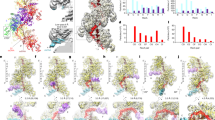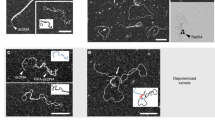Abstract
The products of recombination-activating genes RAG1 and RAG2 mediate the assembly of antigen receptor genes during lymphocyte development in a process known as V(D)J recombination. Lack of structural information for the RAG proteins has hindered mechanistic studies of this reaction. We report here the crystal structure of an essential DNA binding domain of the RAG1 catalytic core bound to its nonamer DNA recognition motif. The RAG1 nonamer binding domain (NBD) forms a tightly interwoven dimer that binds and synapses two nonamer elements, with each NBD making contact with both DNA molecules. Biochemical and biophysical experiments confirm that the two nonamers are in close proximity in the RAG1/2–DNA synaptic complex and demonstrate the functional importance of the protein-DNA contacts revealed in the structure. These findings reveal a previously unsuspected function for the NBD in DNA synapsis and have implications for the regulation of DNA binding and cleavage by RAG1 and RAG2.
This is a preview of subscription content, access via your institution
Access options
Subscribe to this journal
Receive 12 print issues and online access
$189.00 per year
only $15.75 per issue
Buy this article
- Purchase on Springer Link
- Instant access to full article PDF
Prices may be subject to local taxes which are calculated during checkout








Similar content being viewed by others
References
Schatz, D.G., Oettinger, M.A. & Baltimore, D. The V(D)J recombination activating gene, RAG-1. Cell 59, 1035–1048 (1989).
Oettinger, M.A., Schatz, D.G., Gorka, C. & Baltimore, D. RAG-1 and RAG-2, adjacent genes that synergistically activate V(D)J recombination. Science 248, 1517–1523 (1990).
Sawchuk, D.J. et al. V(D)J recombination: modulation of RAG1 and RAG2 cleavage activity on 12/23 substrates by whole cell extract and DNA-bending proteins. J. Exp. Med. 185, 2025–2032 (1997).
van Gent, D.C., Hiom, K., Paull, T.T. & Gellert, M. Stimulation of V(D)J cleavage by high mobility group proteins. EMBO J. 16, 2665–2670 (1997).
Tonegawa, S. Somatic generation of antibody diversity. Nature 302, 575–581 (1983).
McBlane, J.F. et al. Cleavage at a V(D)J recombination signal requires only RAG1 and RAG2 proteins and occurs in two steps. Cell 83, 387–395 (1995).
van Gent, D.C., Mizuuchi, K. & Gellert, M. Similarities between initiation of V(D)J recombination and retroviral integration. Science 271, 1592–1594 (1996).
Hiom, K. & Gellert, M. Assembly of a 12/23 paired signal complex: a critical control point in V(D)J recombination. Mol. Cell 1, 1011–1019 (1998).
Jones, J.M. & Gellert, M. Ordered assembly of the V(D)J synaptic complex ensures accurate recombination. EMBO J. 21, 4162–4171 (2002).
Mundy, C.L., Patenge, N., Matthews, A.G. & Oettinger, M.A. Assembly of the RAG1/RAG2 synaptic complex. Mol. Cell. Biol. 22, 69–77 (2002).
van Gent, D.C., Ramsden, D.A. & Gellert, M. The RAG1 and RAG2 proteins establish the 12/23 rule in V(D)J recombination. Cell 85, 107–113 (1996).
Eastman, Q.M., Leu, T.M. & Schatz, D.G. Initiation of V(D)J recombination in vitro obeying the 12/23 rule. Nature 380, 85–88 (1996).
West, R.B. & Lieber, M.R. The RAG-HMG1 complex enforces the 12/23 rule of V(D)J recombination specifically at the double-hairpin formation step. Mol. Cell. Biol. 18, 6408–6415 (1998).
Steen, S.B., Gomelsky, L. & Roth, D.B. The 12/23 rule is enforced at the cleavage step of V(D)J recombination in vivo. Genes Cells 1, 543–553 (1996).
Critchlow, S.E. & Jackson, S.P. DNA end-joining: from yeast to man. Trends Biochem. Sci. 23, 394–398 (1998).
Fugmann, S.D., Lee, A.I., Shockett, P.E., Villey, I.J. & Schatz, D.G. The RAG proteins and V(D)J recombination: complexes, ends, and transposition. Annu. Rev. Immunol. 18, 495–527 (2000).
Swanson, P.C. The bounty of RAGs: recombination signal complexes and reaction outcomes. Immunol. Rev. 200, 90–114 (2004).
Spanopoulou, E. et al. The homeodomain region of Rag-1 reveals the parallel mechanisms of bacterial and V(D)J recombination. Cell 87, 263–276 (1996).
Difilippantonio, M.J., McMahan, C.J., Eastman, Q.M., Spanopoulou, E. & Schatz, D.G. RAG1 mediates signal sequence recognition and recruitment of RAG2 in V(D)J recombination. Cell 87, 253–262 (1996).
De, P. & Rodgers, K.K. Putting the pieces together: identification and characterization of structural domains in the V(D)J recombination protein RAG1. Immunol. Rev. 200, 70–82 (2004).
Landree, M.A., Kale, S.B. & Roth, D.B. Functional organization of single and paired V(D)J cleavage complexes. Mol. Cell. Biol. 21, 4256–4264 (2001).
Swanson, P.C.A. RAG-1/RAG-2 tetramer supports 12/23-regulated synapsis, cleavage, and transposition of V(D)J recombination signals. Mol. Cell. Biol. 22, 7790–7801 (2002).
Ciubotaru, M. et al. RAG1-DNA binding in V(D)J recombination. Specificity and DNA-induced conformational changes revealed by fluorescence and CD spectroscopy. J. Biol. Chem. 278, 5584–5596 (2003).
Bailin, T., Mo, X. & Sadofsky, M.J.A. RAG1 and RAG2 tetramer complex is active in cleavage in V(D)J recombination. Mol. Cell. Biol. 19, 4664–4671 (1999).
Bellon, S.F., Rodgers, K.K., Schatz, D.G., Coleman, J.E. & Steitz, T.A. Crystal structure of the RAG1 dimerization domain reveals multiple zinc-binding motifs including a novel zinc binuclear cluster. Nat. Struct. Biol. 4, 586–591 (1997).
Matthews, A.G. et al. RAG2 PHD finger couples histone H3 lysine 4 trimethylation with V(D)J recombination. Nature 450, 1106–1110 (2007).
Feng, J.A., Johnson, R.C. & Dickerson, R.E. Hin recombinase bound to DNA: the origin of specificity in major and minor groove interactions. Science 263, 348–355 (1994).
Banerjee-Basu, S. & Baxevanis, A.D. The DNA-binding region of RAG 1 is not a homeodomain. Genome Biol. 3, I1004 (2002).
Aidinis, V. et al. The RAG1 homeodomain recruits HMG1 and HMG2 to facilitate recombination signal sequence binding and to enhance the intrinsic DNA-bending activity of RAG1–RAG2. Mol. Cell. Biol. 19, 6532–6542 (1999).
Swanson, P.C. & Desiderio, S.V. (D)J recombination signal recognition: distinct, overlapping DNA-protein contacts in complexes containing RAG1 with and without RAG2. Immunity 9, 115–125 (1998).
Aravind, L. & Landsman, D. AT-hook motifs identified in a wide variety of DNA-binding proteins. Nucleic Acids Res. 26, 4413–4421 (1998).
Cowell, L.G., Davila, M., Yang, K., Kepler, T.B. & Kelsoe, G. Prospective estimation of recombination signal efficiency and identification of functional cryptic signals in the genome by statistical modeling. J. Exp. Med. 197, 207–220 (2003).
Nagawa, F. et al. Footprint analysis of the RAG protein recombination signal sequence complex for V(D)J type recombination. Mol. Cell. Biol. 18, 655–663 (1998).
Ramsden, D.A., Baetz, K. & Wu, G.E. Conservation of sequence in recombination signal sequence spacers. Nucleic Acids Res. 22, 1785–1796 (1994).
Akamatsu, Y. & Oettinger, M.A. Distinct roles of RAG1 and RAG2 in binding the V(D)J recombination signal sequences. Mol. Cell. Biol. 18, 4670–4678 (1998).
Huye, L.E., Purugganan, M.M., Jiang, M.M. & Roth, D.B. Mutational analysis of all conserved basic amino acids in RAG-1 reveals catalytic, step arrest, and joining-deficient mutants in the V(D)J recombinase. Mol. Cell. Biol. 22, 3460–3473 (2002).
Feeney, A.J., Goebel, P. & Espinoza, C.R. Many levels of control of V gene rearrangement frequency. Immunol. Rev. 200, 44–56 (2004).
Ciubotaru, M., Kriatchko, A.N., Swanson, P.C., Bright, F.V. & Schatz, D.G. Fluorescence resonance energy transfer analysis of recombination signal sequence configuration in the RAG1/2 synaptic complex. Mol. Cell. Biol. 27, 4745–4758 (2007).
Swanson, P.C. The DDE motif in RAG-1 is contributed in trans to a single active site that catalyzes the nicking and transesterification steps of V(D)J recombination. Mol. Cell. Biol. 21, 449–458 (2001).
Zhou, L. et al. Transposition of hAT elements links transposable elements and V(D)J recombination. Nature 432, 995–1001 (2004).
Hickman, A.B. et al. Molecular architecture of a eukaryotic DNA transposase. Nat. Struct. Mol. Biol. 12, 715–721 (2005).
Grundy, G.J., Hesse, J.E. & Gellert, M. Requirements for DNA hairpin formation by RAG1/2. Proc. Natl. Acad. Sci. USA 104, 3078–3083 (2007).
Lu, C.P., Sandoval, H., Brandt, V.L., Rice, P.A. & Roth, D.B. Amino acid residues in Rag1 crucial for DNA hairpin formation. Nat. Struct. Mol. Biol. 13, 1010–1015 (2006).
Santagata, S., Villa, A., Sobacchi, C., Cortes, P. & Vezzoni, P. The genetic and biochemical basis of Omenn syndrome. Immunol. Rev. 178, 64–74 (2000).
Eastman, Q.M. & Schatz, D.G. Nicking is asynchronous and stimulated by synapsis in 12/23 rule-regulated V(D)J cleavage. Nucleic Acids Res. 25, 4370–4378 (1997).
Yu, K. & Lieber, M.R. The nicking step in V(D)J recombination is independent of synapsis: implications for the immune repertoire. Mol. Cell. Biol. 20, 7914–7921 (2000).
Ramsden, D.A., McBlane, J.F., van Gent, D.C. & Gellert, M. Distinct DNA sequence and structure requirements for the two steps of V(D)J recombination signal cleavage. EMBO J. 15, 3197–3206 (1996).
Swanson, P.C. Fine structure and activity of discrete RAG-HMG complexes on V(D)J recombination signals. Mol. Cell. Biol. 22, 1340–1351 (2002).
Swanson, P.C. & Desiderio, S. RAG-2 promotes heptamer occupancy by RAG-1 in the assembly of a V(D)J initiation complex. Mol. Cell. Biol. 19, 3674–3683 (1999).
Bergeron, S., Madathiparambil, T. & Swanson, P.C. Both high mobility group (HMG)-boxes and the acidic tail of HMGB1 regulate recombination-activating gene (RAG)-mediated recombination signal synapsis and cleavage in vitro. J. Biol. Chem. 280, 31314–31324 (2005).
Dai, Y. et al. Determinants of HMGB proteins required to promote RAG1/2-recombination signal sequence complex assembly and catalysis during V(D)J recombination. Mol. Cell. Biol. 25, 4413–4425 (2005).
Mouw, K.W. et al. Architecture of a serine recombinase-DNA regulatory complex. Mol. Cell 30, 145–155 (2008).
Bergeron, S., Anderson, D.K. & Swanson, P.C. RAG and HMGB1 proteins: purification and biochemical analysis of recombination signal complexes. Methods Enzymol. 408, 511–528 (2006).
Otwinowski, Z. & Minor, W. Processing of X-ray diffraction data collected in oscillation mode. Methods Enzymol. 276, 307–326 (1997).
Collaborative Computational Project, Number 4. The CCP4 suite: programs for protein crystallography. Acta Crystallogr. D Biol. Crystallogr. 50, 760–763 (1994).
Sheldrick, G.M. A short history of SHELX. Acta Crystallogr. A 64, 112–122 (2008).
Terwilliger, T. SOLVE and RESOLVE: automated structure solution, density modification and model building. J. Synchrotron Radiat. 11, 49–52 (2004).
Terwilliger, T.C. Maximum likelihood density modification. Acta Crystallogr. D Biol. Crystallogr. 56, 965–972 (2000).
Emsley, P. & Cowtan, K. Coot: model-building tools for molecular graphics. Acta Crystallogr. D Biol. Crystallogr. 60, 2126–2132 (2004).
Murshudov, G.N., Vagin, A.A. & Dodson, E.J. Refinement of macromolecular structures by the maximum-likelihood method. Acta Crystallogr. D 53, 240–255 (1997).
Acknowledgements
We thank the staff at Advanced Photon Source beamline 24ID and National Synchrotron Light Source beamline X25. We are grateful to N. Grindley, L. Regan and A. Miranker for the use of their spectrofluorometers. We also thank W. Eliason and J. Kavran of the Steitz laboratory, S. Unniraman of the Schatz laboratory and the staff of the Center for Structural Biology Core Facility at Yale for their help. This work was supported by the US National Institutes of Health grant AI32524 to D.G.S., training grant T32 GM08283 and a Gershon Fellowship to F.F.Y. This work was also funded by the Howard Hughes Medical Institute (to D.G.S. and T.A.S.).
Author information
Authors and Affiliations
Contributions
F.F.Y. performed all of the experiments shown; F.F.Y. crystallized the complex and solved the structure with help from S.B., S.K. and C.A.I.; S.B. contributed to the structure refinement and making of Figure 2; all other figures were generated by F.F.Y.; M.C. contributed to the design and interpretation of FRET assays; T.A.S. contributed to experimental design and analysis of the structure; D.G.S. contributed to experimental design and data interpretation; F.F.Y. and D.G.S. wrote the manuscript, which all authors commented on.
Corresponding author
Supplementary information
Supplementary Text and Figures
Supplementary Figures 1–7 and Supplementary Table 1 (PDF 6176 kb)
Rights and permissions
About this article
Cite this article
Yin, F., Bailey, S., Innis, C. et al. Structure of the RAG1 nonamer binding domain with DNA reveals a dimer that mediates DNA synapsis. Nat Struct Mol Biol 16, 499–508 (2009). https://doi.org/10.1038/nsmb.1593
Received:
Accepted:
Published:
Issue Date:
DOI: https://doi.org/10.1038/nsmb.1593
This article is cited by
-
Immunological assessment of a patient with Omenn syndrome resulting from compound heterozygous mutations in the RAG1 gene
Immunogenetics (2023)
-
Structural insights into the evolution of the RAG recombinase
Nature Reviews Immunology (2022)
-
Targeting HMGB3/hTERT axis for radioresistance in cervical cancer
Journal of Experimental & Clinical Cancer Research (2020)
-
Biochemical activity of RAGs is impeded by Dolutegravir, an HIV integrase inhibitor
Cell Death Discovery (2020)
-
Functional regulation of an ancestral RAG transposon ProtoRAG by a trans-acting factor YY1 in lancelet
Nature Communications (2020)



